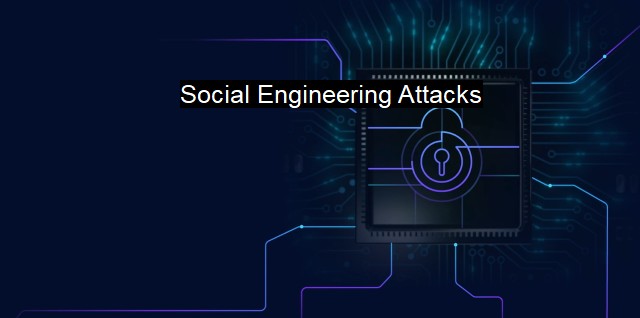What are Social Engineering Attacks?
Understanding and Preventing Social Engineering Attacks: Protecting Against Devastating Cybersecurity Threats
Social engineering attacks refer to manipulation techniques employed by cybercriminals designed to trick users into giving out sensitive information, such as personal data, bank account numbers, passwords, or credit card details. In the context of cybersecurity and antivirus software, social engineering is one of the most prevalent and foolproof methods that hackers employ to breach security frameworks and illicitly gain access to otherwise protected information.Social engineering attacks exploit the single most significant weak link in any security system - the human operator. While software and hardware components can be designed to resist malware and fend off unauthorized intrusion, the human user often remains vulnerable to manipulation and deceit. The hackers disguise themselves and create situations where the victims, often unknowingly, end up assisting in the attack, usually by revealing crucial information or performing certain actions that compromise their security frameworks.
Social engineering attacks come in different forms, each uniquely designed depending on the level of sophistication and the intended target. Well-known types include phishing attacks, baiting attacks, pretexting, scareware, and tailgating attacks. A phishing attack occurs extensively through email, where the attacker disguises as a reputable organization and persuades the user to reveal personal data.
Unlike phishing, baiting attacks promise the user a benefit in exchange for login information or private data. Scareware involves tricking the user into thinking their computer is infected with malware, compelling them to install a dubious software that itself turns out to be a virus. Pretexting relies on creating a false sense of trust between the attacker and the user, while tailgating is an indirect attack usually requiring physical access, where the attacker gains access to a restricted area by closely following a legitimate user.
Even though many antivirus software and cybersecurity platforms continuously introduce protocols to combat these attacks, they remain a significant concern because they target human vulnerability rather than a technical system. This makes them considerably more challenging to detect and prevent, given the intricacies and nuances involved in human behavior and psychology.
Preventing social engineering attacks often involves continuous education and awareness among users about different attack methodologies. On a more technologically tangent line of defense, many organizations resort to regularly upgrading security firewalls, employing intrusion detection systems, and implementing strong password protocols. They also foster a better security culture within the organization by choosing secure software, controlling user access, and discarding sensitive information correctly.
Antivirus software plays a crucial role in protecting against baiting and scareware attacks. For instance, effective antivirus software should identify malicious software and remove it before it infects the system. Also, antivirus software helps limit the damage by isolating the problem and averting further intrusion into the system.
The uniqueness and subtlety of social engineering attacks call for more than just technical measures. Because these attacks exploit human attributes such as trust, curiosity, or fear, organizations also need to instigate comprehensive training and awareness programs. Such programs would equip users with the knowledge and capability to recognize and circumvent potential attacks, thereby diminishing the chances of a successful security breach.
With the rapid extension of digital digitization, more and more sensitive data is stored digitally, increasing the attractiveness for cybercriminals and the potential damages of successful social engineering attacks. While cybersecurity and antivirus technologies keep evolving to confront these threats, so do the strategies of the attackers. Therefore, understanding and preventing social engineering attacks is crucial in the context of modern cybersecurity, representing a constant battle between hackers and security specialists. No system can ever be entirely impervious to security breaches, but vigilant users, regular training, comprehensive defensive strategies, and robust antivirus protection can considerably mitigate the risks posed by social engineering attacks.

Social Engineering Attacks FAQs
What is social engineering attacks?
Social engineering attacks are a type of cybersecurity attack that relies on psychological manipulation techniques to trick people into revealing sensitive information or performing certain actions that benefit attackers.What are some common examples of social engineering attacks?
Some common examples of social engineering attacks include phishing, pretexting, baiting, and quid pro quo.How can antivirus software help protect against social engineering attacks?
Antivirus software can help protect against social engineering attacks by detecting and blocking known malware or suspicious activities, such as downloading or executing malicious files, opening malicious links or attachments, or sending personal information to unknown destinations.What are some ways to prevent social engineering attacks?
Some ways to prevent social engineering attacks include being vigilant and skeptical of unsolicited messages or requests, verifying the identity of the sender or caller, avoiding clicking on suspicious links or downloads, keeping software and security patches up-to-date, and educating employees about cybersecurity best practices.| | A | | | B | | | C | | | D | | | E | | | F | | | G | | | H | | | I | | | J | | | K | | | L | | | M | |
| | N | | | O | | | P | | | Q | | | R | | | S | | | T | | | U | | | V | | | W | | | X | | | Y | | | Z | |
| | 1 | | | 2 | | | 3 | | | 4 | | | 7 | | | 8 | | |||||||